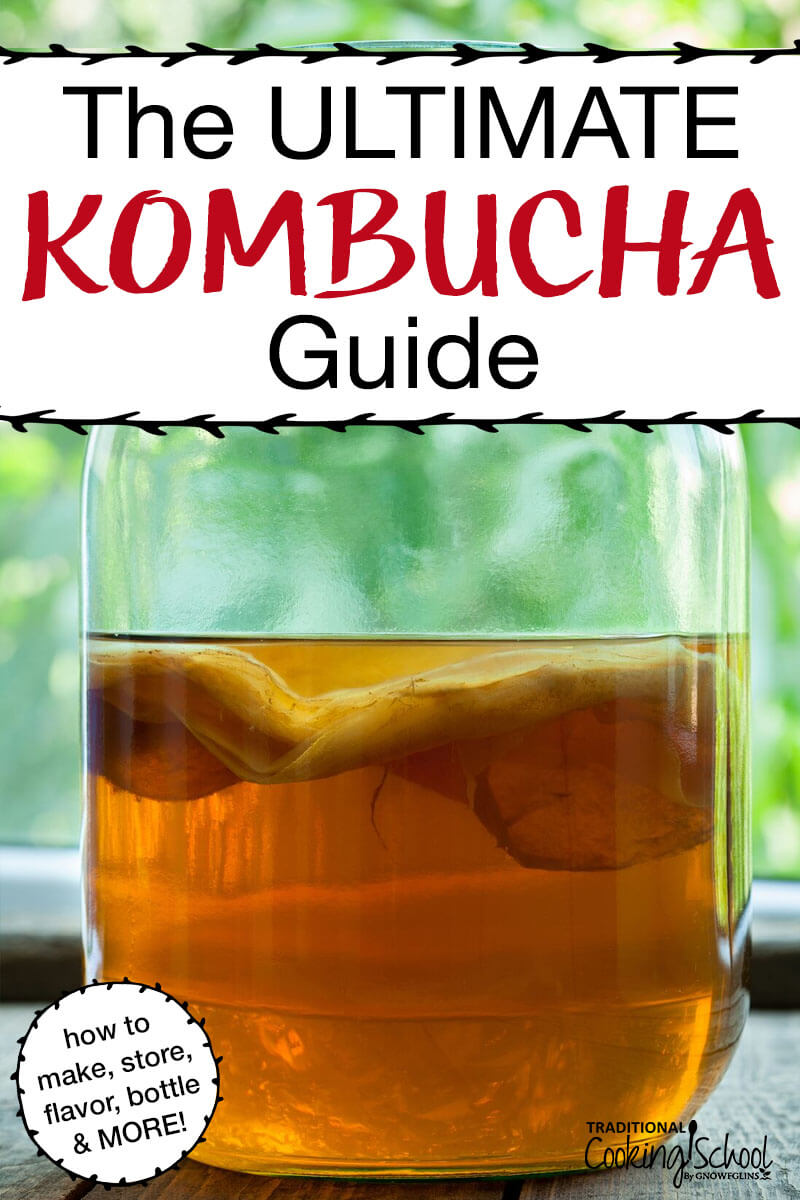

Want this “Ultimate Kombucha Guide” combined into a FREE all-in-one eBook you can refer to offline?
Click here to download the “Ultimate Kombucha Guide” eBook for FREE!
In the world of fermented food and drinks, this one is quite possibly at the top of the list…
Slightly sweet, slightly sour, and a little bit fizzy, we’re in love with KOMBUCHA — the traditional ferment that’s easy enough for a beginner ferment-er and nourishing enough that fermenting veterans keep a batch brewing at all times, too!
At Traditional Cooking School, we get questions about Kombucha regularly…
- How to make it?
- How to flavor it?
- Which sweetener is best?
- Can I make it with honey?
- What do I do if my Kombucha is too sour?
- And sooooo many more!
So, with all your questions and curiosities and tips, we know one thing’s for sure…
You’re as crazy about Kombucha as we are!
Therefore, we’ve put together this invaluable resource: The ULTIMATE Kombucha Guide!
You’ve got Kombucha questions; The ULTIMATE Kombucha Guide has answers!
So… let’s start at the very beginning. Whether you’re new to Kombucha-brewing or you’re an old hat, it never hurts to go back to the basics…
First up?
What Is Kombucha?
Kombucha is a widely known and loved probiotic beverage. You’ve probably seen bottles of Kombucha at your local health food store or even the supermarket. (And boy, are they pricey!)
The origin of Kombucha is a good guess at best. Some sources say it hails from Russia; others claim ancient China as its birthplace. In fact, in China, it was known as the “Immortal Health Elixir”. No matter where it’s from, it’s one of the best ferments for beginners!
Made with tea, water, a whole sweetener, finished Kombucha, and a Kombucha SCOBY (the mother culture; a symbiotic colony of bacteria and yeasts), it’s both sweet and sour. Through the miracle of fermentation, sweet tea becomes a beverage that’s loaded with…
- B vitamins
- enzymes
- probiotics
- antioxidants
- beneficial acids, like acetic acid and glucaronic acid
It’s also naturally fizzy, thanks to the carbon dioxide that the bacteria and yeasts let off as they “eat” the sweetener. Because these little guys need food in order to turn sweet tea into Kombucha, the sweetener is absolutely necessary.
But, don’t worry… Kombucha has very little (if any) sugar left once it’s finished brewing. And, the longer you let it ferment, the more sour (less sugar) it becomes.
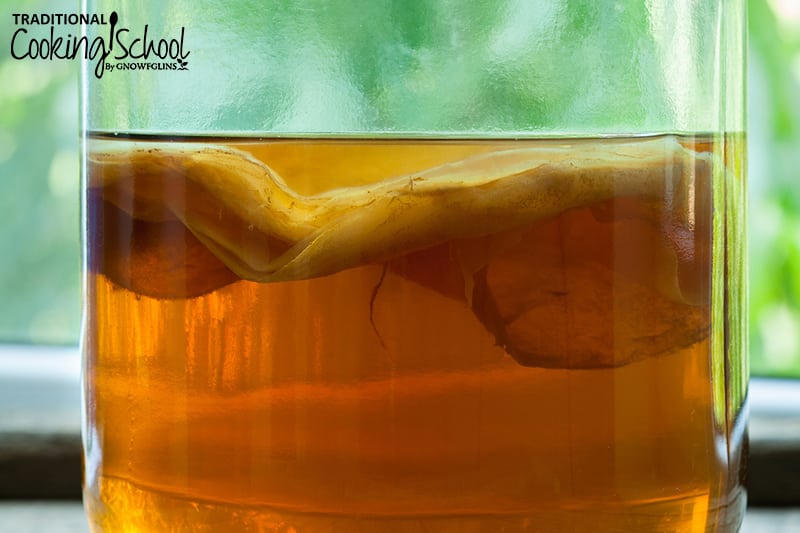
What Are The Benefits Of Kombucha?
Kombucha tastes delicious, yet it is also a traditional superfood with benefits like…
- improving digestion
- repopulating the gut with healthy bacteria and yeasts
- strengthening the immune system
- reducing oxidative stress on cells
- improving liver detox
- improving mental health, thanks to its concentration of B vitamins and gut-healing abilities
- satisfying cravings for carbonated beverages
(Source.)
Are you convinced that Kombucha is a powerfully healing and beneficial beverage? And you’re ready to make it? 🙂
The Best Ingredients To Use For Brewing Kombucha
Ready to make your own Kombucha? Great! Start here with my Kombucha recipe.
First, what tea(s) to use?
You can use all of one type of tea (such as black or white tea) or mix and match 2 or more teas to create custom blends.
If you’ve never made Kombucha before, it’s wise to start with plain, organic black tea. As your brew and SCOBY get stronger, you can begin mixing it up.
Here are some lovely teas to try:
- Green tea
- Oolong tea
- Jasmine tea
- White tea
- Yerba Mate tea
- Rooibos tea
- Kombucha Tea Blend from Get Kombucha
You may use decaffeinated tea if you prefer, although, like the sweetener, most of the caffeine is consumed during fermentation.
Second, which sweetener is best?
Organic raw cane sugar or evaporated cane juice has been the preferred sweetener for generations of home kombucha brewers. It’s affordable and easily sourced.
However, if you’re very sensitive to sugar, following the Paleo or AIP lifestyle, or healing your gut through the GAPS Diet, then you should make your Kombucha with raw honey as we do. (More on this below.)
Considering using alternative sweetener? Check out this article to answer the question “Can I Use Alternative Sweeteners in Ferments?”
Third, you’ll need a Kombucha SCOBY and some unflavored, finished Kombucha as a starter.
It’s wonderful (and the least expensive option) if you can get a SCOBY and starter Kombucha from a friend.
If you can’t, we recommend the SCOBYs from Cultures For Health and Get Kombucha. The Cultures For Health SCOBYs are dehydrated and require re-hydrating. The Get Kombucha SCOBYs are packaged with the starter liquid, require no re-hydrating, and can be used right away.
If you can’t obtain starter from a friend or Get Kombucha, use plain, store-bought Kombucha.
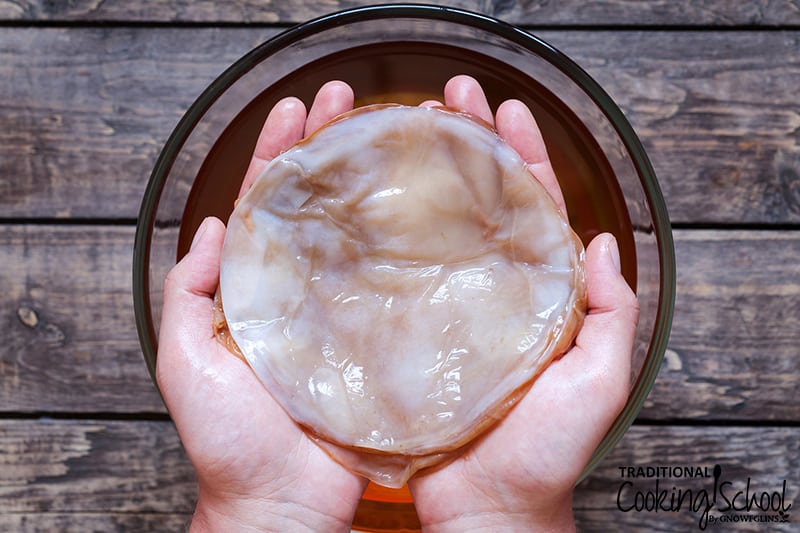
Finally, you need a vessel in which to brew your Kombucha.
Whether a jar, bowl, large canister, or other vessel, make sure to use glass or lead-free porcelain — not plastic! We used gallon-size glass jars for Kombucha for years — and brewed up to 7 gallons at a time.
Then, we discovered the Continuous Brew System from Get Kombucha. Now, we love this method for brewing several gallons of Kombucha at a time — since our family drinks SO much!
Can I Make Kombucha With Honey?
You sure can! In fact, I did an entire episode of #AskWardee about using honey for Kombucha.
Our family has come to prefer Kombucha made with honey because we know that, if there is any leftover sweetener, it’s a beneficial one.
Even though most of the sugar gets consumed during the fermentation, not all of it does. Whatever amount is left is too much for us. We don’t want to eat any sugar.
We avoid sugar to maintain our gut health — even though we aren’t technically on the GAPS Diet — and to healthfully manage our weight and keep our energy up. So personally, we prefer to use honey in our Kombucha for these reasons.
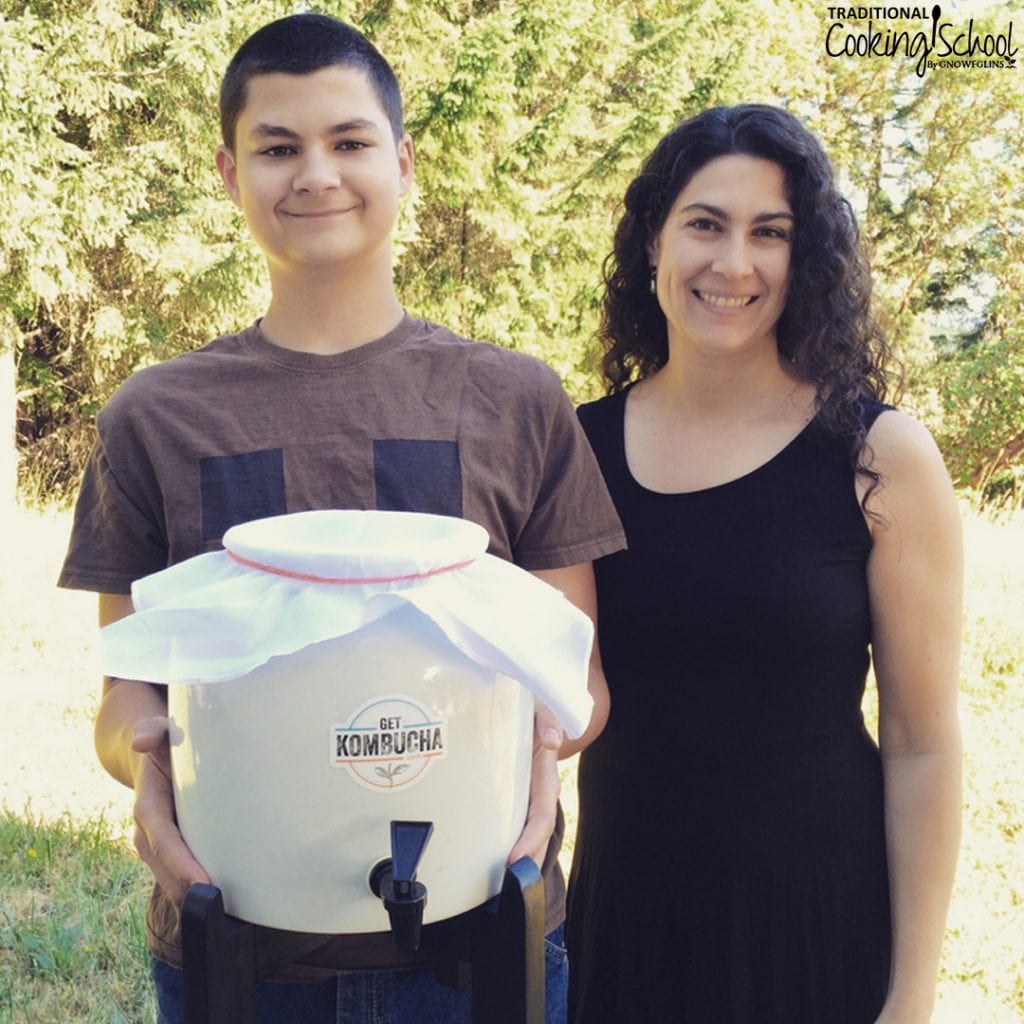
What Is The Continuous Brew Method?
I use the Continuous Brew System and 2.5 gallon fermenting crocks from Get Kombucha. (Here’s a video of me unboxing this system.)
If you make a lot of Kombucha, this is the system you need to use! Before this system, we often had as many as 7 gallon jars of Kombucha fermenting on our counter. It took up SO much space!
Now, we can brew more Kombucha with less space in the same amount of time. Here’s a podcast I did with Dave Lindenbaum on this system as well as how he healed acid reflux with Kombucha.
Learn more about the Kombucha Kits from Get Kombucha.
How Can I Flavor My Kombucha?
Flavoring Kombucha is also known as a “second ferment”…
And, it’s really easy! Taking a few minutes for this extra step means…
- You’ll save money over buying flavored Kombucha from the store.
- You can wean your family off sodas.
- The “wow” factor of your Kombucha goes way up.
- More carbonation builds up so your finished Kombucha has way more fizz!
In fact, you can use just about anything to infuse your home brew with wonderful flavors.
- fresh fruit — like berries, cherries, and pineapple
- frozen fruit (here’s how)
- dried fruit — like apricots, figs, raisins, mangoes, and apples
- freeze-dried fruit — like strawberries and mangoes
- fresh rhizomes, like ginger and turmeric (here’s a Ginger & Turmeric Kombucha recipe!)
- dried spices, like ground cinnamon and cloves
You can even change how you flavor your Kombucha with the seasons. For instance, Ginger Grapefruit Kombucha is wonderful on a hot, summer day.
During the fall and winter, you can switch to other seasonal flavors, like Pear-Ginger-Clove and Apple Pie! (Here are 5 Kombucha Flavors For Fall.)
To bottle (aka second ferment) Kombucha, all you need are glass swing-top bottles and fruits and/or spices of choice. Simply place 6 to 10 pieces of cut up, dried fruit (or about 1/4 cup fresh or frozen) into the bottoms of the glass bottles. Then, fill with finished Kombucha, close, and set in a warm place for 1 to 3 days. If your home is cold, a seedling warming mat will help.
For more information on bottling your Kombucha, watch my free #AskWardee video!
Speaking of bottling…
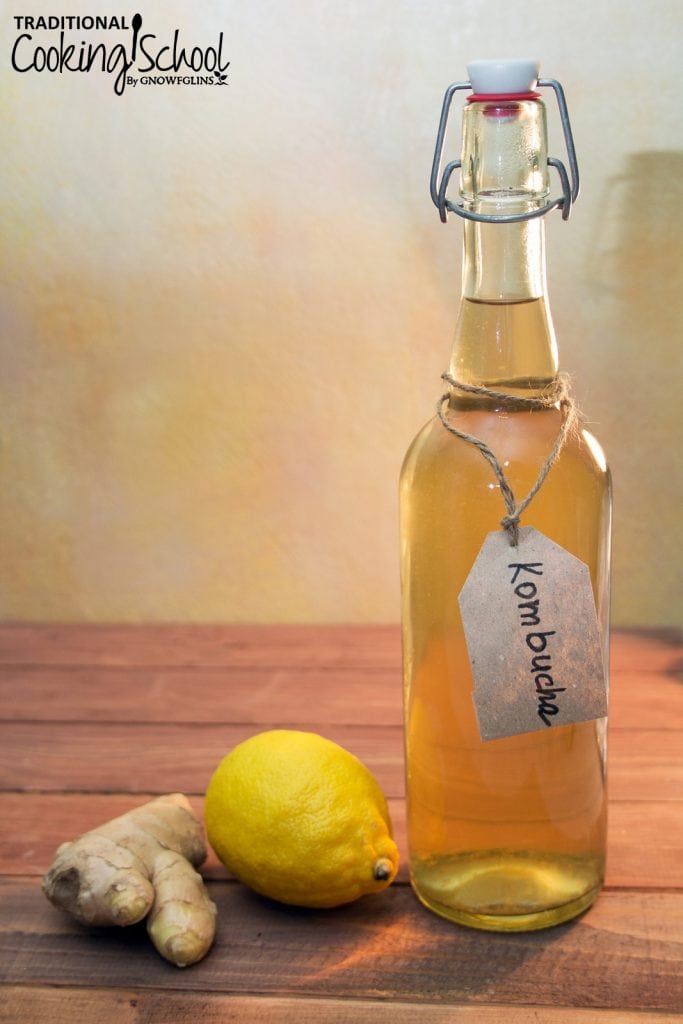
How Should I Store My Finished Kombucha?
Though you can’t see them, Kombucha contains tiny bacteria and yeasts that will continue to feed on the remaining sugars, even after the brew is finished. As long as it has warmth, sugar, and oxygen, the fermentation process will continue. Remove one of these factors, and fermentation stops…
Which is vital if your Kombucha tastes just like you want it to and you’re ready to store it!
Thus, it is necessary to store finished Kombucha in airtight containers in the fridge, especially so it doesn’t get too sour. (See below for what to do with sour Kombucha.)
The best way to store finished Kombucha? Glass, swing-top bottles in the fridge!
These are airtight, and you can safely store finished Kombucha in them in the refrigerator for months and months, without the Kombucha turning sour.
If you don’t want to purchase swing-top bottles, the next best thing is brand-new seals for Mason jars. It doesn’t matter if the ring is new or not; but the seal needs to have plenty of wax on it to keep air out.
Decanting Kombucha Is Messy… Is There A Better Way?
If your spigot gets clogged with culture pieces or pouring from jars is messy, you can use food-grade tubing to transfer the first fermented Kombucha from the large fermenting vessels into the individual bottles. The downside to this is you have to “start the flow” by putting your mouth on the hose and sucking out the air, which creates a vacuum for the Kombucha to flow so it can fill your bottle.
However, if you’re worried about serving that Kombucha to people outside your house, try an (inexpensive!) auto bottling siphon like this (pictured above) to decant quickly and easily!
Although it takes a bit to get the hang of it, it works a lot like food grade tubing, except you don’t have to put your mouth on any tubes. So, you can feel completely comfortable serving your Kombucha to family and friends. 🙂 Learn more about decanting Kombucha in my #AskWardee episode!
Can I Do Anything Else With Kombucha?
Besides drink it, you mean? 😉
Sure! If you really have lots of extra Kombucha, here are some ideas…
- Use it to soak beans.
- Use it to soak grains.
- Make Kombucha Jello!
- Use super sour Kombucha as a vinegar replacement in homemade salad dressing.
- Use it as the liquid base for smoothies.
- Make a dairy-free sorbet.
- Boost your sourdough starter.
- Use it in place of vinegar in homemade ketchup and mustard.
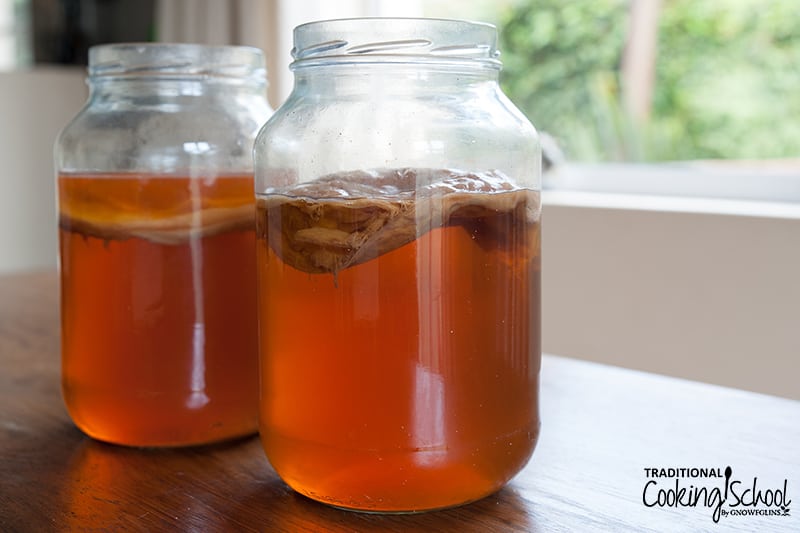
Kombucha Troubleshooting
From Kombucha that’s too sweet to Kombucha that’s too sour…
From cloudiness and stringy bits to weird growths on SCOBYs…
We’ve heard it all! Let’s take these common issues one at a time.
Why Is My Kombucha So Sweet?
There are a few reasons this could be happening, like…
It hasn’t fermented long enough. If this is the case, give it a few more days or move it to a warmer spot to speed up fermentation.
Your SCOBY wasn’t used to the tea or the sweetener. It takes time for ferments to adjust to new things, like a different tea, sweetener, or environment. The best thing to do is wait. Warmth always helps, so try moving your Kombucha to a warmer spot.
The SCOBY is too small for the amount of tea. Your SCOBY should be 1/2″ to 1″ thick for a gallon of Kombucha. Any smaller than this, and it may not be able to efficiently and effectively turn the sweet tea into Kombucha. Try brewing in smaller batches until you can build up your SCOBY’s thickness.
Your location wasn’t warm enough. As with all ferments, Kombucha loves a warm — not hot — spot. Its ideal temperature is between 72 and 76 degrees Fahrenheit. Colder months can be an especially hard time for Kombucha SCOBYs because they’re cold if your house is cold. Try relocating your Kombucha to above your fridge or oven, to an upstairs room, or to a high shelf. This is also when you might find a seedling warming mat handy!
Why Isn’t My Kombucha Fizzy?
It’s a huge let-down to hear all about the wonderful bubbliness of Kombucha only to experience flat Kombucha when you make it yourself. Here are a few reasons why you might experience a lack of fizz:
It hasn’t fermented at all or hasn’t fermented long enough. No fermenting = no fizz. Again, give it more time and/or move it to a warmer spot to encourage those bacteria and yeasts to get to work.
The SCOBY is too small. Ideal thickness is 1/2″ to 1″ for a gallon of Kombucha. If your SCOBY is too small, it can’t properly ferment the tea, resulting in a brew that’s too sweet and not fizzy. Try a smaller amount until your SCOBY is thicker.
Your SCOBY is too young. Often, your SCOBY just isn’t mature enough to produce a fizzy Kombucha. In this case, give it time. 😉 With each new batch of Kombucha, your SCOBY will be older and stronger, resulting in a more sour, more fizzy brew.
The container for the second ferment isn’t air-tight. If air can get out, it can’t build up. That’s why we recommend doing a second ferment in glass, swing-top bottles or in Mason jars with tight lids. Just make sure not to leave them at room or warm temperature too long or you *might* have explosions.
Learn more about how to fix Kombucha that’s too sweet and not fizzy in my free #AskWardee video.
My Kombucha Is Too Sour… Yuck!
Is your Kombucha tasting a little too much like apple cider vinegar? Well, that’s because it fermented long enough to become vinegar — Kombucha vinegar!
Or, are you brewing so much that you can’t finish drinking one batch before the batch you’re brewing sits too long and gets really sour?
Here are my suggestions:
First, try slowing down the fermentation by moving your Kombucha to a cooler location. Be careful that it’s not too cool, though. If the temperature is too cool, your SCOBY will get moldy and smelly instead of making Kombucha.
Second, give bottling a try. Bottling Kombucha essentially stops the fermentation process right where it’s at. So, if you taste your brew, and it’s perfect … but you’re not done drinking the previous batch … bottle it right then and there! Put it in the fridge, and it will still taste like you want when you’re ready to drink it.
What Can I Do With Really Sour Kombucha?
So, you let it go too far… No need to throw it out! Now you have Kombucha vinegar. 🙂 Kombucha vinegar is a wonderful ingredient to have, so too-sour Kombucha isn’t a total waste.
First, try sweetening your sour Kombucha with some stevia or honey. Stir in the sweetener to taste. If you just can’t get it “right”…
Use it for soaking! Kombucha (especially really sour Kombucha) is an acidic medium, like lemon juice, whey, and raw apple cider vinegar. So, it does a nice job of breaking down phytic acid in grains, nuts, and beans. Here’s how to use Kombucha for soaking.
Use it anywhere you would use apple cider vinegar. Really. 😉
- Add a cup to your laundry to soften and get odors out of fabrics.
- Add 1 cup super sour Kombucha to 1 gallon of water and water plants. The Kombucha adds acidity to the soil.
- Use it as a skin toner. Wet a cotton ball with Kombucha and rub across your face. Air-dry and follow with moisturizer.
- Add a cup or two to bathwater for a detoxifying soak.
- Rinse your hair with it to restore softness and shine.
Learn more about using too-sour Kombucha in my free #AskWardee video.
My SCOBY Is HUGE… Help!
After a few weeks of brewing, your SCOBY should be growing. Actually, your SCOBY may have many layers and be several inches thick!
Every batch of Kombucha produces new growth on your SCOBY — kind of like tree rings in a tree! This new growth can be peeled off and shared with a friend. Not to worry… peeling off SCOBY layers won’t hurt your SCOBY. 🙂 Just be sure to leave about an inch-thick SCOBY for yourself, then share away! (Here’s how to divide a SCOBY for sharing.)
If your SCOBY is so thick and has so many layers that you can’t think of one more person to share with, it’s time to create “housing” for those extra layers. We call this a SCOBY Hotel. 😉 This is a large, glass container with the sole purpose of safely storing your extra SCOBYs until they can be used or given away. Learn how to create your own SCOBY Hotel.
You’ve given away SCOBYs, you’re housing SCOBYs, and you still have SCOBYs coming out your ears… Now what??
Well, SCOBYs are totally edible… So, if it’s not too weird or “out there” for you, try SCOBY Jerky and SCOBY Fruit Leather!
What About Mold?
Your Kombucha SCOBY will grow new, creamy-white layers with every new batch of Kombucha.
The older layers (on bottom) will turn brown over time and may even grow stringy bits that will get into your brew. You can strain these out, if you prefer; however, there’s no harm in drinking them.
As with any ferment, you should always be on the lookout for mold…
New Kombucha layers grow in evenly — not in patches or spots. They start out as a slightly cloudy, very thin layer at first, and then thicken during fermentation.
If your Kombucha SCOBY (the mother culture) develops mold, it looks similar to mold you’ll find on old bread: fuzzy and green, grey, or blackish. The key word being fuzzy.
Smooth brown, black, or grey marks are not mold. Grey or black specks are not mold. Brown, smooth blobs, brown tendrils, sediment in the brewer — nope, not mold.
Sometimes people mistake the thin, translucent and possibly flecked new growth at the top of the SCOBY as mold, but it’s not mold either. That’s the SCOBY growing babies! 😉
Fuzzy green, grey, or blackish — that’s what Kombucha mold looks like.
Does this mean you have to throw it out?
Unfortunately, yes. You’ll need to start over. 🙁
First, clean your containers very well with hot, soapy water. Then…
Obtain a new SCOBY, some fresh starter Kombucha, and begin again. Here’s 5 tips on how to prevent mold during fermentation.
Other Fermented Beverages
- How To Make Kombucha
- The ULTIMATE Water Kefir Guide
- 50+ Probiotic & Fermented Drinks Beyond Kombucha & Kefir!
- How To Make Beet Kvass
- Is Jun Right For You? All Your Questions Answered!
- Honey-Sweetened Ginger Beer {probiotic, non-alcoholic, GAPS-friendly natural soda!}
- Spontaneously Fermented Sparkling Apple Cider
- 5-Minute Probiotic Mixed Berry Switchel {Paleo, GAPS, AIP}
Do you make Kombucha? Share your tips, tricks, and troubleshooting in the comments! Or, if you have a question I didn’t answer, share it too!
...without giving up the foods you love or spending all day in the kitchen!

2 free books:
Eat God's Way
Ditch the Standard American Diet, get healthier & happier, and save money on groceries...
We only recommend products and services we wholeheartedly endorse. This post may contain special links through which we earn a small commission if you make a purchase (though your price is the same).

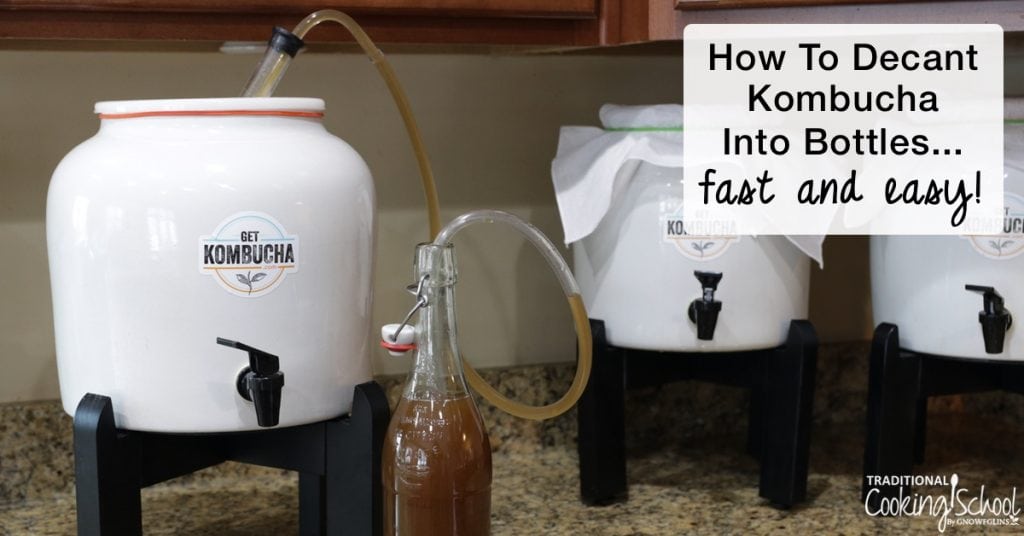
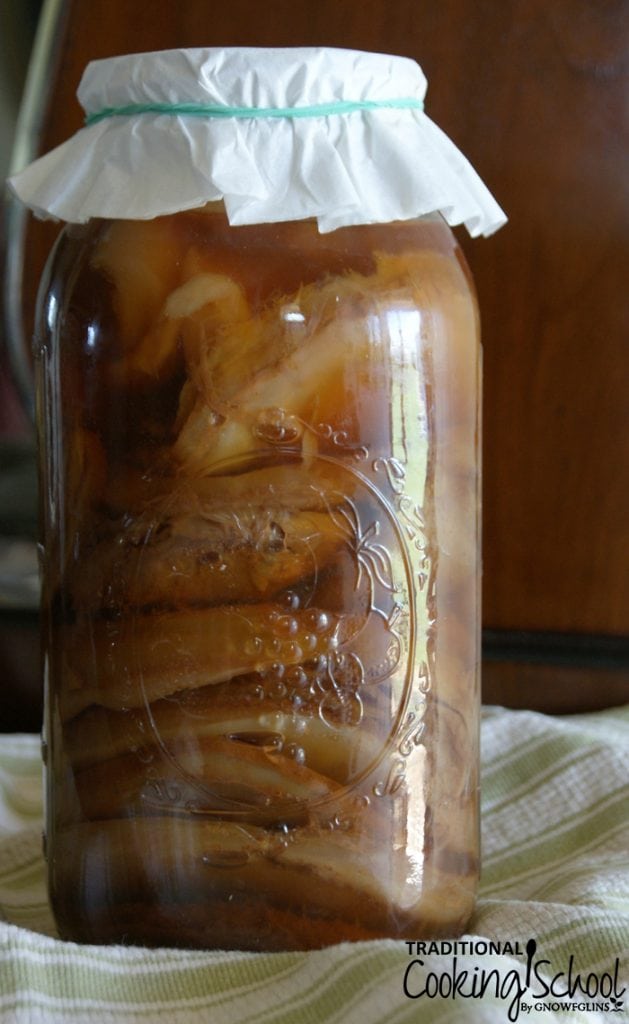

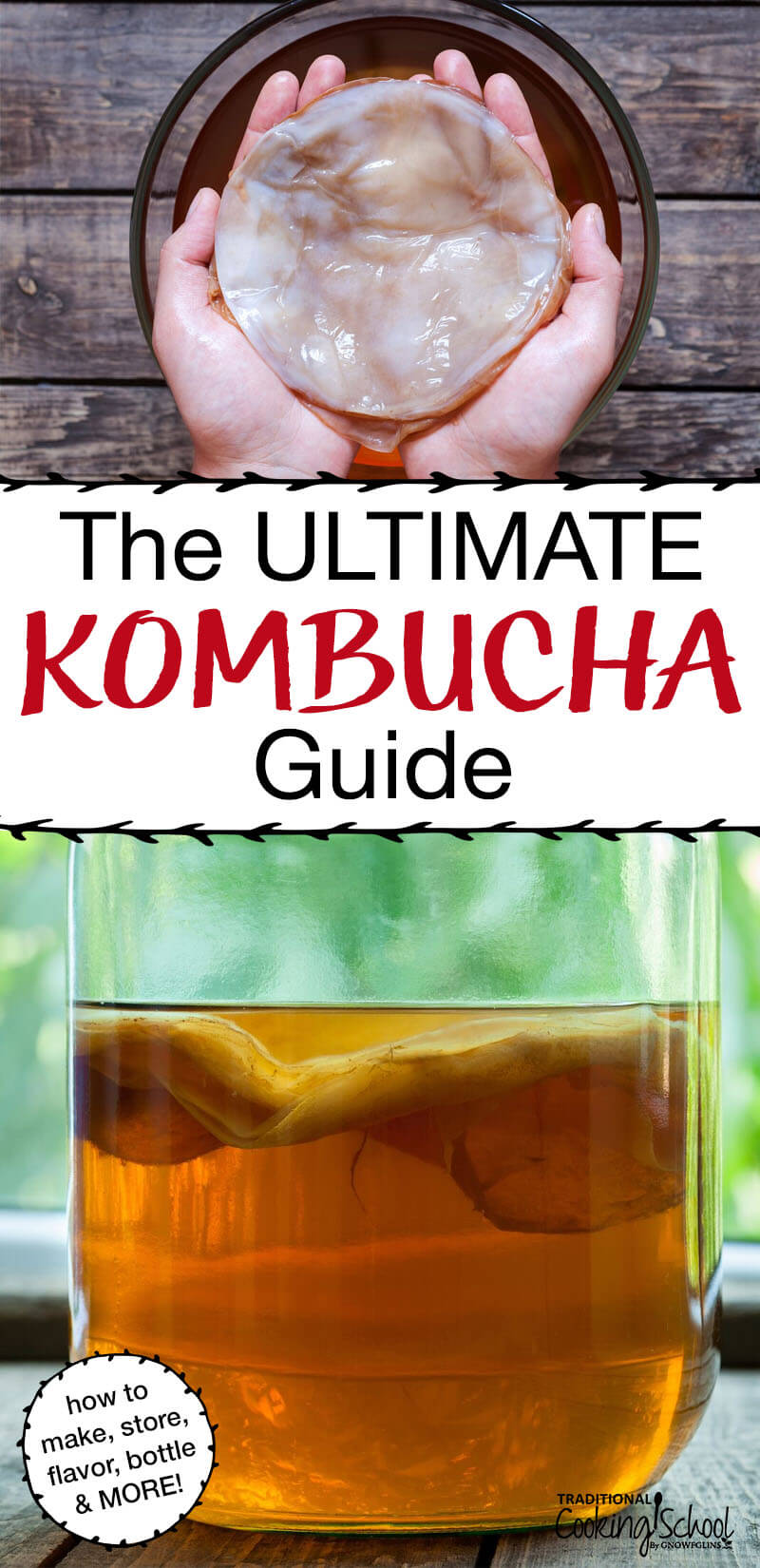
I have a question and I hope you haven’t already answered and I missed it . I bought a scoby at a Craft Fair and will be making my first batch of kombucha . My family can have teas, but I cannot have black, white or green tea. Can I use an herbal-only tea? I know you said Rooibos but I dislike the flavor and am hoping other herbals would work . Thanks so much, Wardee !
Hi Cheryl,
When you brew with herbal teas over time, due to the lack of necessary nutrients, the culture will atrophy and eventually die. You could occasionally use herbal teas and be sure you keep healthy mothers on back up.
~ Millie, TCS Customer Success Team
I need to reduce the size of the scoby that was given to me. It is a fairly large square with the corners rounded off and it is folded over in quarters. It is too big for my needs as I only brew a 750ml amount at a time in a jar. It is not thick enough to separate horizontally so can I cut it to make a smaller round shape to fit my jar? how can I do it if I cannot use a metal knife or scissors to do the job?
I look forward to your reply.
Hi, Jill:
If your scoby is not thick enough to peel apart, you can use a sharp knife to cut it. While you should avoid touching the scoby with metal as much as possible, it won’t hurt it to just use a sharp metal knife once to cut it apart.
Sonya
TCS Customer Success Team
I just wanted to know if you know of a way of making my own scoby from some store bought kombucha?
Hi Crystal,
If you buy raw, unflavored kombucha you can start a scoby from it.
Section #3 in this article gives more details: https://www.culturesforhealth.com/learn/kombucha/obtaining-a-kombucha-scoby/?a_aid=56e447f050113
~Danielle, TCS Customer Success Team
I made scoby with flavored kombucha, just as an experiment. I had raw ginger kombucha, I left 1 -2 inch of kombucha fluid in the bottle and poured strong black tea directly into the bottle. Forget I had done it:) But after a month or so when I rediscovered the bottle, it had 3 pancakes growing in it. very healthy too! I ignored it for another month and it grew into 3 chunky scoby. Is there any harm in using it to making kombucha?
Hi Lisa,
No problem, give it a try! You may find that your finished kombucha has a hint of ginger.
~ Vicki, TCS Customer Success Team
Hello!
Ive made my own scoby from store bought kombucha and after just a few days a film had formed on top. That was 6 weeks ago and since there’s been barely any change. It’s cold where I live, the average temp was 19-20C (I think that’s 68F), but I see a lot of articles saying 65-76F is optimal. I have since moved it to my bedroom which is a few degrees warmer, but that was over a week ago and still no progress (despite warmer days when the sun made the temp go up to 25C for a few hours). It smells of vinegar when I stick my nose in.
Do I start a new small batch and “try again” or wait longer, or feed it more sugar and tea, or what do I do? The film is still translucent, with just some small spots of white (but no mould)
Hi, Mari.
I recommend feeding it more sugar tea and if you can keep it warmer that may help.
~Danielle, TCs Customer Success Team
So I have SCOBY with starter fluid. I make a little black tea with sugar, cool to temp and then place all of the ingredients carefully in a big half gallon jar… put a tightly woven cloth on the mouth of jar and then wait to see what happens next? The gal I bought it from said it was easy but didn’t provide the most clear instructions… she said to make a cup of tea. ? then said she makes enough tea to fill the half gallon jar. I’m sort of confused.
Here is a recipe you can use:
https://traditionalcookingschool.com/food-preparation/recipes/kombucha-recipe/
Enjoy!
~Peggy, TCS Customer Success Team
Hello, thanks for sharing your recipe. My kombucha came out great but it lacked the bubbly fizz the store brands have.
First batch 21 days
Second batch 28 days.
Hi, Charles.
This article may help: https://traditionalcookingschool.com/q-a/askwardee/askwardee-024-help-kombucha-sweet-not-fizzy/
~Danielle, TCS CustomerSuccess Team
Hi,
I just made my first batch of kombucha! 🙂 my new scoby started to grow and I placed both in a container. My new scoby is not attached to the old one, is that okay? The new scoby is still very thin, I started a new batch today and I put both in, but now I’m wondering if I should have done that?
Hi, Molly.
It is okay that your scobys aren’t attached and that you put both in. They may grow together, they may not.
Scobys sometimes seem to have a mind of their own. 🙂
~Danielle, TCS Customer Success Team
After the second fermentation, how do you remove the fruit before bottling?
Hi Margi, yes you should remove the fruit after the second ferment and before bottling.
~ Vicki, TCS Customer Success Team
Hi,
I’ve been making Kombucha and sharing it with my family for over 10 years now. Our youngest daughter and her husband are now pregnant and she wants to continue drinking Kombucha. Are there any precautions we should be aware of?
Hi, Margaret: I’m happy to help! Kombucha does contain a small amount of alcohol (like all fermented foods), so your daughter might choose to avoid it. Here’s a link to an episode of Ask Wardee in which Wardee explores this topic: https://traditionalcookingschool.com/food-preparation/do-lacto-ferments-contain-alcohol-askwardee-127/ — Sonya, TCS customer success team
I have been making kombucha now for almost 2 years. I was getting ready to make my batch today and there’s little white worms on top of my Scoby. I’m assuming that means throw it out but what would make it do that?
Hi, Theresa.
We have not heard of worms growing on a scoby. The acidic environment would prevent them from hatching. Unless your scoby has not been kept in kombucha I, then perhaps it is possible. It could be strings of new scoby growth but if you’re unsure I would toss and start again.
~Danielle, TCS Customer Success Team
Hi Theresa, I have been making bucha for 10 years and have never seen white worms. Are they moving? How big? Can you post a picture? I am super curious.
Fruit flies make little white larva that can look like worms. Possibly fruit flies got into your culture, hope you started over! Don’t ever use cheese cloth to cover your culture and make sure the rubber bands holding on your close-woven cloth or coffee filters are TIGHT.
I just finished growing my first scoby from a live bottle of Kombucha I bought from the store. It took 5 weeks. Is this normal? Now what do I do? Do I put the entire scoby the with the new tea and throw away the old tea? Do I put the mother scoby in a “hotel” and use the old tea as a starter? Do I store the hotel in the refrigerator? The Imformation isn’t clear. Please help. Thank you.
Debbie
Hi, Debbie,
It all depends on the environment with your home. Here are some links you may find helpful:
https://traditionalcookingschool.com/food-preparation/recipes/kombucha-recipe/?swcfpc=1
https://traditionalcookingschool.com/food-preparation/recipes/techniques-tutorials/divide-kombucha-scoby-aw083/?swcfpc=1
https://traditionalcookingschool.com/food-preparation/recipes/how-to-create-a-scoby-hotel/?swcfpc=1
You can also do a quick search in the search bar and she has a lot more information there as well. 🙂
~Peggy, TCS Customer Success Team
I find that I lose all the fizz I created in the 2nd fermentation when I strain the fruit and re-bottle it. I don’t like chunks of fruit in my final product. Do you have any tips for keeping the fizz after straining the 2nd fermentation?
Hi Briana, you could set out the bottles for a few more hours after straining the fruit and regain some of the fizz. Just leave the bottles topped and let sit at room temperature for a few hours. You could also add a small amount of sugar when you leave the bottles out, if you felt that will help with the fizz. ~ Vicki, TCS Customer Succes Team